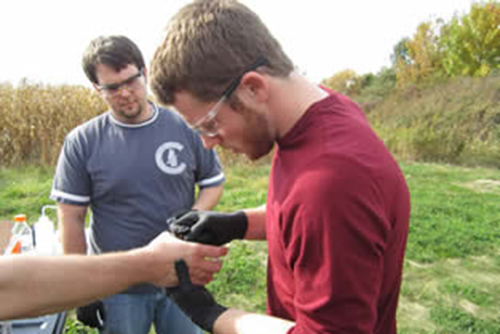TV shows like CSI may not be reality, but a nearly $300,000 grant from the National Institutes of Justice (NIJ) will allow an interdisciplinary research team at Illinois State University to explore the viability—and the legal uses—of new crime-scene technology.
The team, comprised of faculty members Christopher Mulligan, Jamie Wieland, and Michael Gizzi, will take the next two years to explore uses of a new version of a mass spectrometer—lab equipment that is often used in forensic analysis.
“If you look at how the entertainment industry personifies forensics, we’re not there yet, but much like cell phones did in the last few years, the technology is really taking off,” said Mulligan, who is leading the Illinois State team working with the NIJ.
It was Mulligan, a professor of analytical chemistry, who developed a smaller, easily usable, version of the mass spectrometer. The device is intended for field use, as a means of quickly analyzing materials in investigations, such as illegal drugs. The NIJ grant will allow the team to explore not only the uses of this “portable mass spectrometer,” but also possible ethical, legal, and financial questions that may accompany it.
“This device can be a game changer as far as giving real-time information to investigators on site, but it also brings up new questions about privacy for suspects,” said Wieland, an associate professor of technology who will provide her expertise in statistics and operations management. She will delve into a cost-benefit analysis of the device. “This is an expensive piece of equipment,” Wieland said of the device that can cost up to $100,000 per unit. “It is potentially cost effective on a federal level, but what about on a state level, or even a county level? That we don’t know yet.”
Gizzi, an associate professor of criminal justice studies, will tackle potential legal issues that could come with the use of the device. “This is geared toward use in an investigative format, before an arrest is made,” he said. “That means there are a different set of legal issues involved than those after an arrest. This is ultimately a tool used in a search.”
The NIJ grant is unique in that it looks beyond the science of developing next-generation chemical instrumentation, and into the ramifications. “It is so sensitive that it can analyze drug residue on a driver’s license,” said Wieland. “Would an officer be able to use this at a traffic stop? And should that officer be able to use it? Those are the types of questions we are exploring.”
Mulligan agreed by adding, “to demonstrate the technology is one thing, but to figure out what you should do with it, and what not to do with it is very important.
The grant will run from January 2016 to January 2017.
Read an expanded story on their research project in the upcoming March issue of the Redbird Scholar.
For interviews with Mulligan, Wieland and Gizzi, contact Media Relations at (309) 438-5744 or at MediaRelations@IllinoisState.edu.

